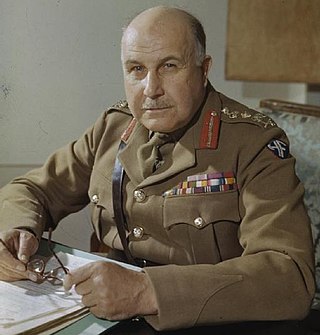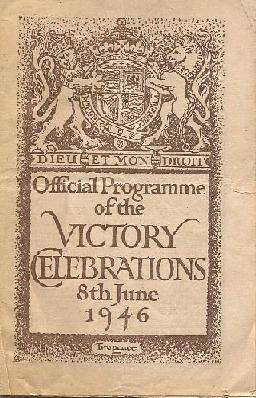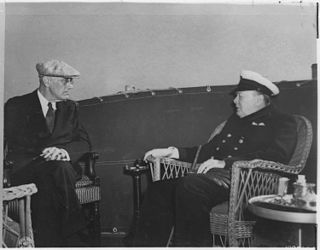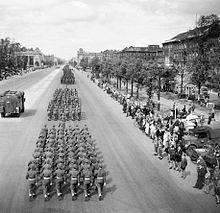
Field Marshal Bernard Law Montgomery, 1st Viscount Montgomery of Alamein, nicknamed "Monty", was a senior British Army officer who served in the First World War, the Irish War of Independence and the Second World War.

Sir Winston Leonard Spencer Churchill was a British statesman, soldier, and writer who was twice Prime Minister of the United Kingdom, from 1940 to 1945 during the Second World War, and 1951 to 1955. Apart from 1922 to 1924, he was a Member of Parliament (MP) from 1900 to 1964 and represented a total of five constituencies. Ideologically an adherent to economic liberalism and imperialism, he was for most of his career a member of the Conservative Party, which he led from 1940 to 1955. He was a member of the Liberal Party from 1904 to 1924.

Field Marshal Henry Maitland Wilson, 1st Baron Wilson,, also known as Jumbo Wilson, was a senior British Army officer of the 20th century. He saw active service in the Second Boer War and then during the First World War on the Somme and at Passchendaele. During the Second World War he served as General Officer Commanding-in-Chief (GOC-in-C) British Troops in Egypt, in which role he launched Operation Compass, attacking Italian forces with considerable success, in December 1940. He went on to be Military Governor of Cyrenaica in February 1941, commanding a Commonwealth expeditionary force to Greece in April 1941 and General Officer Commanding (GOC) British Forces in Palestine and Trans-Jordan in May 1941.

Field Marshal Alan Francis Brooke, 1st Viscount Alanbrooke,, was a senior officer of the British Army. He was Chief of the Imperial General Staff (CIGS), the professional head of the British Army, during the Second World War, and was promoted to field marshal on 1 January 1944. As chairman of the Chiefs of Staff Committee, Brooke was the foremost military advisor to Prime Minister Winston Churchill, and had the role of co-ordinator of the British military efforts in the Allies' victory in 1945. After retiring from the British Army, he served as Lord High Constable of England during the Coronation of Queen Elizabeth II in 1953. His war diaries attracted attention for their criticism of Churchill and for Brooke's forthright views on other leading figures of the war.

Victory in Europe Day is the day celebrating the formal acceptance by the Allies of World War II of Germany's unconditional surrender of its armed forces on Tuesday, 8 May 1945; it marked the official end of World War II in Europe in the Eastern Front, with the last known shots fired on 11 May.

The final battles of the European theatre of World War II continued after the definitive surrender of Nazi Germany to the Allies, signed by Field marshal Wilhelm Keitel on 8 May 1945 in Karlshorst, Berlin. After German leader Adolf Hitler's suicide and handing over of power to grand admiral Karl Dönitz on the last day of April 1945, Soviet troops conquered Berlin and accepted surrender of the Dönitz-led government. The last battles were fought on the Eastern Front which ended in the total surrender of all of Nazi Germany’s remaining armed forces such as in the Courland Pocket in western Latvia from Army Group Courland in the Baltics surrendering on 10 May 1945 and in Czechoslovakia during the Prague offensive on 11 May 1945.

The Combined Chiefs of Staff (CCS) was the supreme military staff for the United States and Britain during World War II. It set all the major policy decisions for the two nations, subject to the approvals of British Prime Minister Winston Churchill and U.S. President Franklin D. Roosevelt.
The First Washington Conference, also known as the Arcadia Conference, was held in Washington, D.C., from December 22, 1941, to January 14, 1942. President Roosevelt of the United States and Prime Minister Churchill of the United Kingdom attended the conference, where they discussed a future United Nations, and representative of the Allies adopted the United Nations Declaration.

The 1945 Moscow Victory Parade, also known as the Parade of Victors, was a victory parade held by the Soviet Armed Forces after the defeat of Nazi Germany. This, the longest and largest military parade ever held on Red Square in the Soviet capital Moscow, involved 40,000 Red Army soldiers and 1,850 military vehicles and other military hardware. The parade lasted just over two hours on a rainy June 24, 1945, over a month after May 9, the day of Germany's surrender to Soviet commanders.

The London Victory Celebrations of 1946 were British Commonwealth, Empire and Allied victory celebrations held after the defeat of Nazi Germany and Japan in World War II. On 1 November 1945 the Prime Minister appointed a committee under the chairmanship of the Home Secretary, James Chuter Ede to formulate plans for official Victory Celebrations. The celebrations took place in London on 8 June 1946, and consisted mainly of a military parade through the city and a night time fireworks display. Most British allies took part in the parade, including Belgium, Brazil, China, Czechoslovakia, France, Greece, Luxembourg the Netherlands and the United States.

The Malta Conference was held from January 30 to February 3, 1945 between President Franklin D. Roosevelt of the United States and Prime Minister Winston Churchill of the United Kingdom on the island of Malta. The purpose of the conference was to plan the final campaign against the Germans with the Combined Chiefs of Staff. Politically, the overriding purpose was to present a united front against Stalin in the Yalta Conference a few days later. That did not happen once Yalta began, much to Churchill's disappointment. Both leaders agreed on the undesirability of the Red Army advancing into central Europe.

The Allied leaders of World War II listed below comprise the important political and military figures who fought for or supported the Allies during World War II. Engaged in total war, they had to adapt to new types of modern warfare, on the military, psychological and economic fronts.

The Third Washington Conference was held in Washington, D.C from May 12 to May 25, 1943. It was a World War II strategic meeting between the heads of government of the United Kingdom and the United States. It was the third conference of the 20th century, but the second conference that took place during the US involvement in the Second World War. The delegations were headed by Winston Churchill and Franklin D. Roosevelt, respectively.

The following events occurred in July 1945:

The following events occurred in May 1945:

The Berlin Victory Parade of 1945 was held by the Allies of World War II on 7 September 1945 in Berlin, the capital of the defeated Germany, shortly after the end of World War II. The four participating countries were the Soviet Union, the United States, the United Kingdom, and France.

The following events occurred in June 1945:
The following is a timeline of the first premiership of Winston Churchill, who was the Prime Minister of the United Kingdom from 1940 to 1945 and again from 1951 to 1955. Churchill served as the Prime Minister of the United Kingdom during the bulk of World War II. His speeches and radio broadcasts helped inspire British resistance, especially during the difficult days of 1940–41 when the British Commonwealth and Empire stood almost alone in its active opposition to Nazi Germany. He led Britain as Prime Minister until victory over Nazi Germany had been secured.

Winston Churchill was appointed First Lord of the Admiralty on 3 September 1939, the day that the United Kingdom declared war on Nazi Germany. He succeeded Neville Chamberlain as prime minister on 10 May 1940 and held the post until 26 July 1945. Out of office during the 1930s, Churchill had taken the lead in calling for British re-armament to counter the growing threat of militarism in Nazi Germany. As prime minister, he oversaw British involvement in the Allied war effort against the Axis powers. Regarded as the most important of the Allied leaders during the first half of the Second World War, Historians have long held Churchill in high regard as a victorious wartime leader who played an important role in defending Europe's liberal democracy against the spread of fascism. For his wartime leadership and for his efforts in overseeing the war effort, he has been consistently ranked both by scholars and the public as one of the top three greatest British prime ministers, often as the greatest prime minister in British history.
This is a list of events from British radio in 1945.















